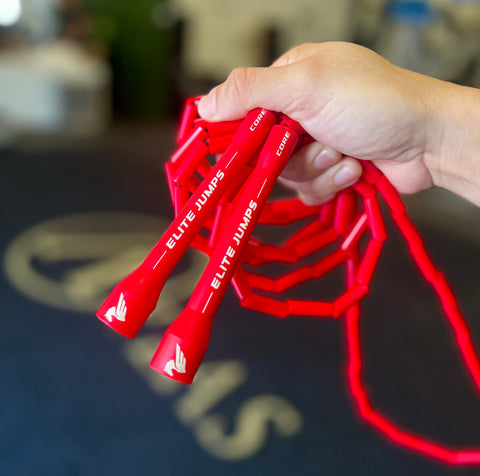Understanding Your Jump Rope: Anatomy, Design, and Optimal Usage Tips
Jun 11, 2024Devin Meek

Jump ropes have evolved from simple childhood playthings to essential fitness tools. Understanding their anatomy can significantly enhance your workout efficiency and results.

A jump rope isn’t a complicated piece of equipment. Basically, it consists of three parts:
1. Handles
High-quality jump rope handles are designed for comfort and grip. They are also ergonomically shaped and often covered with a non-slip material. That helps reduce hand fatigue and allows for longer, more intense workouts.
2. Spin mechanism
The handles can be rotated smoothly 90 or 180 degrees to ensure rapid rotation, without friction and entanglement. It also reduces torque that could otherwise bend, warp, or even snap the rope. Precision ball bearings in the handles enable the jump rope to spin smoothly and quickly with minimal friction. This is vital for maintaining a consistent speed and rhythm.
The question is: are bearings a must?
The truth is that you can do everything, double unders included, on a rope without bearings. So don’t worry if your jump rope doesn’t come with them.
3. Rope Material
The rope itself is crucial. Its material determines, among other things, the skill level required, the durability of the jump rope, and the rotation speed. At Elite Jumps, for example, we offer 6mm jump rope cable options to suit different jumping styles and physical abilities.
We believe that creating a jump rope is much more than just assembling a set of parts. For us, it involves a design process that starts with an analysis of all the muscles that are activated when jumping rope. This allows us to make conscious decisions based on ergonomics.

We also take into account different rope materials, since they give you varying amounts of durability and performance when jumping. Some of the most common are:
Another aspect to consider is the functionality of rope materials. For example, bearings are perfect for those who want to practice speed. On the other hand, beads are the go-to option for freestylers.
When it comes to the length of our jump ropes, we’ve set a standard. All of them come with a 10-foot cord or cable by default, unless otherwise specified. This size fits anybody up to 6' 4" tall for general fitness jumping.
Now that you know the basics of jump rope anatomy, it’s time to optimize the usage of this loyal fitness equipment.
There’s a common misconception that the best way to size your rope is to stand in the middle of it and pull the handles up along your body, making them reach your armpits. While this technique is a good place to start, it’s too general to guarantee a perfect fit.
That’s why we recommend you size your rope based on the type of jumping you plan to be doing:
Of course, to adjust the length of your jump rope it is important that it’s resizable. The good news is that here at Elite Jumps all of our jump ropes are incredibly easy to adjust and shorten to fit as needed.
The quality of your jump rope always matters, even if you’re just a beginner. Ideally, you should take your first steps with a jump rope that offers you enough tension and feedback – two aspects that will develop your coordination, rhythm, and timing. We recommend starting with a simple beaded rope or PVC rope because they have the right weight and don’t hurt you when you miss.
One aspect to consider here is the durability of your rope, since it’s a piece of fitness equipment that will be dropped on the floor and hit the ground with every jump. A durable jump rope is one that maintains its integrity and functionality despite regular and rigorous use. Durability in a jump rope means it can handle various surfaces, resist wear and tear, and maintain its shape and flexibility over time.
There’s a myth among jumpers that you need to move your shoulders and elbows constantly to spin your jump rope effectively. But the truth is this only leads to rapid fatigue and affects your rhythm. The secret to minimizing arm movement is to focus on only using your forearms and wrists.
The key behind a great jump rope session is taking some time to stretch before and after working out. This helps in muscle recovery, prevents injuries, and makes you feel great as you jump.
Any time that you finish jumping it’s really important that you roll up your jump rope correctly:
The circle should be roughly about the size of one handle. If you follow these instructions, you won't have to untangle your jump rope the next time you want to use it.
 |
About the AuthorDevin Meek is the Director of Education for Elite Jumps. He's been a jump rope entertainer for over eighteen years and is a three-time world champion competitive jumper. Devin travels the country sharing his passion for the sport, giving jump rope workshops to schools, CrossFit gyms, and corporate wellness programs. |
We're all about equipping and encouraging people to take on big challenges, because we know the process of doing hard things helps us grow in character and capacity.
Frequently bought together
You may also like
0 Comments
There are no comments for this article. Be the first one to leave a message!